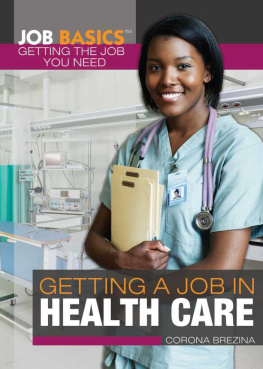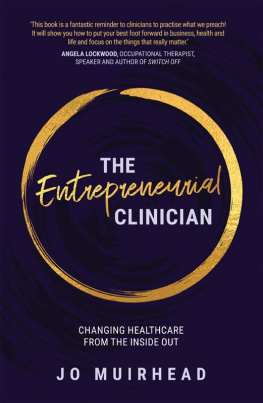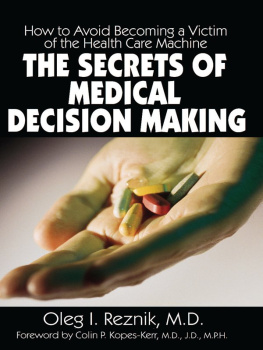Relationship Power in Health Care: Science of Behavior Change, Decision Making, and Clinician Self-Care
John B. Livingstone, M.D.
Joanne Gaffney, R.N., LICSW

CRC Press
Taylor & Francis Group
6000 Broken Sound Parkway NW, Suite 300
Boca Raton, FL 33487-2742
2015 by Taylor & Francis Group
CRC Press is an imprint of Taylor & Francis Group, an Informa business
No claim to original U.S. Government works
Version Date: 20160114
International Standard Book Number-13: 978-1-4822-6429-6 (EPUB)
This book contains information obtained from authentic and highly regarded sources. Reasonable efforts have been made to publish reliable data and information, but the author and publisher cannot assume responsibility for the validity of all materials or the consequences of their use. The authors and publishers have attempted to trace the copyright holders of all material reproduced in this publication and apologize to copyright holders if permission to publish in this form has not been obtained. If any copyright material has not been acknowledged please write and let us know so we may rectify in any future reprint.
Except as permitted under U.S. Copyright Law, no part of this book may be reprinted, reproduced, transmitted, or utilized in any form by any electronic, mechanical, or other means, now known or hereafter invented, including photocopying, microfilming, and recording, or in any information storage or retrieval system, without written permission from the publishers.
For permission to photocopy or use material electronically from this work, please access www.copyright.com or contact the Copyright Clearance Center, Inc. (CCC), 222 Rosewood Drive, Danvers, MA 01923, 978-750-8400. CCC is a not-for-profit organization that provides licenses and registration for a variety of users. For organizations that have been granted a photocopy license by the CCC, a separate system of payment has been arranged.
Trademark Notice: Product or corporate names may be trademarks or registered trademarks, and are used only for identification and explanation without intent to infringe.
Visit the Taylor & Francis Web site at http://www.taylorandfrancis.com
and the CRC Press Web site at www.crcpress.com
CRC Press is a premier publisher of scientific, technology and medical content, reaching around the globe to publish the pioneering achievements of science that provide researchers, professionals, and students with the resources they need to make further advances. CRC Press is a member of Taylor & Francis Group, an informa business.
For more authoritative books in your field and for in-depth information about CRC Press books, visit www.crcpress.com
- Join our email list to receive exclusive, unadvertised discounts and alerts when new books publish in your field
- Visit Featured Authors to learn about your favorite author with detailed bios, news about their work, and discussions of their research
- Read the latest book reviews from industry experts, influencers, and thought leaders about STM (Science, Technology and Medicine) reference and textbooks
The tables in this ebook have been modified to enhance the reader experience. On compatible devices, the enhancement should keep the header rows visible as you scroll through a table.
Please report any issues with this ebook or any desired enhancements to the .
www.crcpress.com
To Hal Stone, Sidra Stone, and Dick Schwartzpioneer clinicians and sensitive observers who took the worlds understanding of human personality and relationships to a new level
Preface
It was during the polio epidemic of 1955. On one ward were dozens of men and women lined up and paralyzed from the neck down, in iron lung machines, unable to breathe on their own or to speak. But they could hear just fine. Even as a second-year medical student, I realized before long that many of the doctors and nurses, including me, were saying things about our patients that they could hear. The adventitious comments in earshot of patients, like, These infections are stubborn! were taken personally and increased their suffering and sense of hopelessness. Our talking was mostly designed to relieve our stress, not to help our patients. Months later, much to my remorse, the survivors told me how the unconnected, seemingly critical comments from the mouths of clinicians only increased their sense of despair. Even though it was inadvertent, I felt badly about my part in it.
For years afterward, while making solo evening rounds as a trainee in pediatric surgery, my focus on what we say that we wish our patients hadnt heard was strengthened. Clinical comments like, Lets cut out his penicillin, said on group rounds within a childs earshot got transformed by the mind of one 5-year-old into terrifying words like, Lets cut out his penis. Before the penicillin was stopped, that child developed his first fever spike in a week. The possible impact on patient outcome of the clinicianpatient relationship began to pique my curiosity. Research was emerging, also, that diabetes II onset in teenagers correlated with a recent divorce or death in their family. I realized that unprocessed emotions and out-of-tune comments in earshot of patients were the tip of an iceberg of out-of-sync patient care that needed attention.
My interest in tracking and understanding relational processes in patient care piqued again seven years later during my first year as faculty in child and adolescent psychiatry. I discovered a whole collection of parents who had shopped among many clinicians for answers about their childrenwhich was both expensive and wasteful. My first hypothesis was that a more integrative approach would fix it. Fortunately, I knew a pediatrician/neurologist who was conversant with child emotional development, a child psychologist who used testing flexibly, and a trusted clinical social worker who respected the role of parents and pediatricians. We started an experimental diagnostic clinic that integrated our four disciplines. Having learned that what clinicians describe they have said and done with their patients is significantly different from what a mentor or the same clinician might directly observe, we included a technology for observing our work in real time. A lot gets lost in the translation that is significant, especially for trainees. I recommended that we build a one-way mirror suite to observe each others interviews and to integrate our process and findings. We called it Team Clinic for Children and evaluated one child and parent(s) in a condensed 3-hour-long session in a single morning. Even the insurance companies liked it and gave us a unique procedure code.
The clinic became a teaching center for students and trainees from each of our four disciplines and for nurses. The total clinical and teaching impact was greater than the simple sum of the parts. The questions of why parents shopped from clinic to clinic kept us focused on parental alliance-building. I thought, What is the point of obtaining accurate diagnoses of children if the communication with and engagement of their parents lagged behind? Team Clinic became a last-stop child evaluation clinic, not mostly by increasing accuracy of child diagnosis but by making advances in parent engagement and communication of evidence-based information (Livingstone, 1968). The fix for costly parental shoppingwhile the childs symptoms became entrenchedturned out to include the integration of disciplines and the enhancement of the parentclinician relationship.








